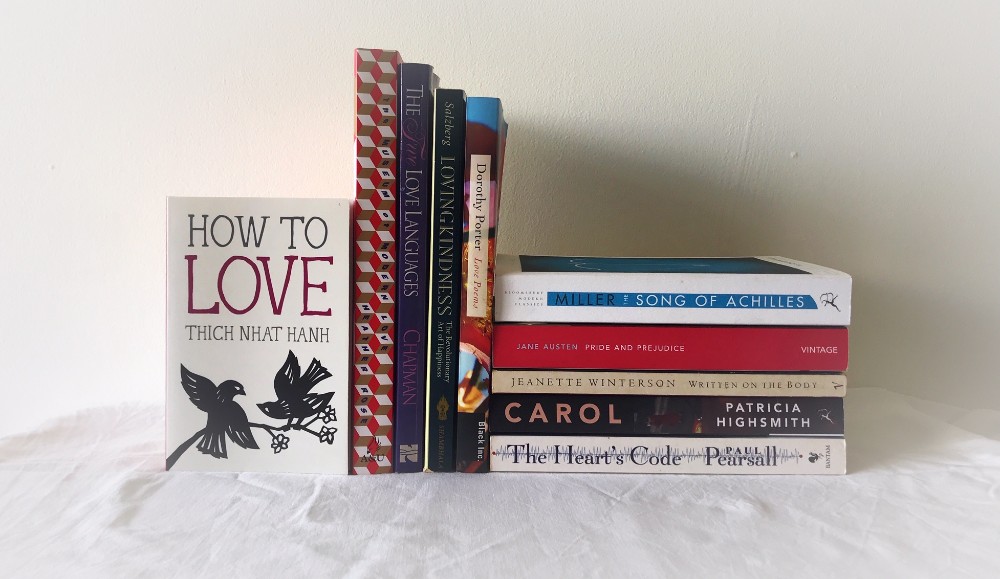Love – to love and be loved – is one of the most important things in the world to me.
But I’m not a fan of the annual day that apparently celebrates love, Valentine’s Day.
For every person I see swooning in a halo of hearts and roses, I know there’s at least one person feeling loss or alone. For me, the day does not embody love.
But. Like all those other commodified holidays, it’s a great opportunity to look at the day’s intent and how it’s relevant to our lives.
 I went to my bookshelf – not just looking for books about love but also looking for a way to understand what love could be.
I went to my bookshelf – not just looking for books about love but also looking for a way to understand what love could be.
It may come as no surprise that there were very few books on my shelf that would classify as romance. Patricia Highsmith’s 1952 novel, Carol (aka The Price of Salt) may be the exception. I love this book. Not because of the love story (which FYI is a tad dysfunctional) but because it was the first book published that represented a relationship between women that did not end in tragedy. It is a very transgressive love story for the 1950s – and strangely still rings true today.
And then I stumbled on another classic that still has something to say to readers contemplating questions of love today. We may no longer be seeking single men in want of a good wife but Jane Austen’s Pride and Prejudice give us such a delightful, quick-witted and sensible protagonist in Lizzie Bennet that it remains relevant today.
If we venture into contemporary literary fiction then Jeanette Winterson goes to the heart of the matter with her opening sentence of Written On The Body, which asks, “Why is the measure of love loss?” Oh, the anguish. Why, indeed.
 Continuing on the literary path there’s Madeleine Miller’s retelling of The Iliad as a love story between two men, The Song of Achilles, and asks all those Is-Love-Greater? questions in Ancient Greece.
Continuing on the literary path there’s Madeleine Miller’s retelling of The Iliad as a love story between two men, The Song of Achilles, and asks all those Is-Love-Greater? questions in Ancient Greece.
And there’s Heather Rose’s contemporary novel, The Museum of Modern Love, asking questions of life and love (and art) through the story of Marina Abramovic and her MOMA performance/exhibition, The Artist is Present.
 While we’re considering words of love as performance, one of the most captivating and thrilling author readings I’ve experienced was Dorothy Porter reading her poetry in the 1990s. Her physical being was alive with her words, presence and passion. I only have to glance through the words of her Love Poems and I can imagine her reading, alive once again.
While we’re considering words of love as performance, one of the most captivating and thrilling author readings I’ve experienced was Dorothy Porter reading her poetry in the 1990s. Her physical being was alive with her words, presence and passion. I only have to glance through the words of her Love Poems and I can imagine her reading, alive once again.
The current bestselling book on love, The Five Love Languages by Gary Chapman, was also first published in the 90s. Chapman has a simple message: There are different ways of expressing love ie the five love languages. I include it here because, for many, it has been the-right-book-at-the-right-time and helped reframe their relationships.
For a different take on matters of the heart, Paul Pearsall’s The Heart’s Code explores the intelligent heart and the field of energy cardiology. This was a revolutionary idea in the 90s – and still is, really – but there are things in this world we do not know, yet. So if you’re up for some pretty expansive, out-there heart-focused questions about energy and quantum physics and emotion then Pearsall’s book is a little toe-dip for you.
And finally, we could not leave our bookish tour de love without getting a bit meta – and bringing it back to what this is really all about; to love is to connect with ourselves and others.
Thich Nhat Hanh’s How To Love allows you ponder love and also how to bring it to life. Metta doesn’t get much better than Sharon Salzberg’s Lovingkindness.
 While I couldn’t find a copy of it on my bookshelf, I’d also include bell hooks’ exploration of what love is and what love can be, All About Love. Whilst acknowledging the baggage of love, hooks also highlights the importance of love in our public and private lives, the importance of self-love, and the importance of understanding love as a verb.
While I couldn’t find a copy of it on my bookshelf, I’d also include bell hooks’ exploration of what love is and what love can be, All About Love. Whilst acknowledging the baggage of love, hooks also highlights the importance of love in our public and private lives, the importance of self-love, and the importance of understanding love as a verb.
That’s the wonderful thing about love. It’s not just about boy meets girl or even girl meets girl meets boy meets boy meets non-binary identified human. It’s about connecting with other humans (and living things and the planet).
To love and be loved.
Valentine’s Day? Galentine’s Day? Palentine’s Day?
On this 14th February – and every day – let’s open our hearts and minds, connect with ourselves and others, reclaim the day, and share the love.

